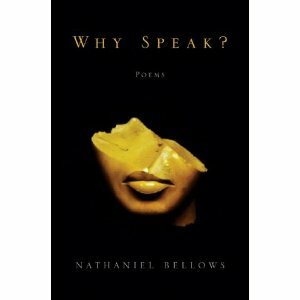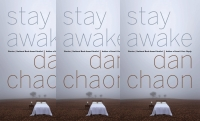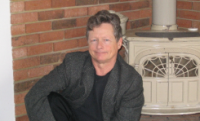In the course of searching out your poetry and stories, I discovered your artwork! The duality of the writer/artist always intrigues me and surprises me a little. In your experience, does one medium stretch the limits of the other? How does the way you create art relate to the way you approach a story?
 When I was a kid I was always drawing—well before I could read—so I think the impulse to capture something, whether from real life or from my imagination, has always been within me. At this point, however, the two disciplines are so intertwined—seeing the work as it develops, in word or in image—that I can’t imagine one taking place without the other. For my novel, On This Day, I drew the story as I wrote it, mostly because I was so unsure about how to write a novel and I was so comfortable with drawing. And in the end, the combination of approaches really helped me build the story, both visually and in terms of the narrative. I wrote about this very topic, in relation to my poetry, for the W.W. Norton “Poems Out Loud” site.
When I was a kid I was always drawing—well before I could read—so I think the impulse to capture something, whether from real life or from my imagination, has always been within me. At this point, however, the two disciplines are so intertwined—seeing the work as it develops, in word or in image—that I can’t imagine one taking place without the other. For my novel, On This Day, I drew the story as I wrote it, mostly because I was so unsure about how to write a novel and I was so comfortable with drawing. And in the end, the combination of approaches really helped me build the story, both visually and in terms of the narrative. I wrote about this very topic, in relation to my poetry, for the W.W. Norton “Poems Out Loud” site.
Your story, “First Four Measures” which was selected by Michael Chabon for Best American Short Stories 2005, is one I’ve read many times and I’m always struck by its empathy and understanding of the human need for attachment. The sensation of the piano teacher’s hand on the narrator’s face stays with me, as does the watchful presence of the house sitter who becomes a true friend. I know you’ve received many and varied reactions to this story over the years- how do they match up with your original hopes and intentions?
I really appreciate all the reactions I’ve gotten to this story, because it’s a relatively quiet, understated story, and yet it often seems to hit a nerve—sometimes someone will appreciate how it evokes the “human need for attachment” as you put it, or sometimes they’re disturbed and/or intrigued by the teacher/student, child/house-sitter dynamics at the center of the piece. (I’ve also noticed that many people identify with the predicament the boy finds himself in with his teacher.) For the most part, however, I’d say the reactions are exactly what I’d hoped for—mostly because people have been extremely kind in their responses. My goal in writing the story was to explore the notion of loneliness in people of different ages and backgrounds, and to look at an individual’s desire to find a form of personal expression, with all its inherent dangers and complexities.
There’s strong sense of place and landscape in your work–wondering about the title of your poetry collection, Why Speak? Does the landscape sometimes speak for you?
 At the risk of sounding strange, I guess I would say that the landscape has always spoken to me. I was lucky enough to grow up in a pretty rural environment—or at least with access to various remote landscapes—and as a result, the presence of the natural world often takes center stage in my work. I live in New York City now, and it’s only been relatively recently that I’ve started to write about the urban landscape; but even then, I find I apply a pastoral sensibility to it—focusing on the trees along the street rather than the street itself, etc. Often the pieces of art I admire most have a secure, realized environment as a foundational element. The British writer Penelope Fitzgerald is one of my favorite authors and the critic Michael Hoffman said of her work: “In Mrs. Fitzgerald’s novels, you can breathe the air and taste the water.” That notion of palpable “realness” is what I’m always striving for in my work.
At the risk of sounding strange, I guess I would say that the landscape has always spoken to me. I was lucky enough to grow up in a pretty rural environment—or at least with access to various remote landscapes—and as a result, the presence of the natural world often takes center stage in my work. I live in New York City now, and it’s only been relatively recently that I’ve started to write about the urban landscape; but even then, I find I apply a pastoral sensibility to it—focusing on the trees along the street rather than the street itself, etc. Often the pieces of art I admire most have a secure, realized environment as a foundational element. The British writer Penelope Fitzgerald is one of my favorite authors and the critic Michael Hoffman said of her work: “In Mrs. Fitzgerald’s novels, you can breathe the air and taste the water.” That notion of palpable “realness” is what I’m always striving for in my work.
Your first novel On This Day deals with the difficult topic of sustained grief in the aftermath of the narrator’s loss of both parents. I keep thinking about the characters in this book and filling in the blanks of their lives outside the confines of the story, so clearly they became very real to me. Their mother, in particular, is sort of wraith-like but she is very much an erratic driving force. Did you ever consider making it her story?
Thanks for saying that about the characters—they all became very real to me, too. (So much so that I couldn’t quite let them go; I’ve actually written the sequel to On This Day, which is still on my computer, to be released….who knows when? [if ever].) I never thought of making the book about the mother, because I knew that it was a story about the resilience of siblings, and how two very different people—Warren, the brother and narrator, and his older sister Joan—must redefine what “family” is in the wake of their parents’ death. Once the context of their relationship/connection is gone—their parents—the question they must ask is: Who are we to each other? If we are so different, and don’t really get along, can we go our separate ways? Warren and Joan are denied so much when this tragedy occurs, that this choice—to stay together or break apart—is an odd kind of empowerment. In the face of such helplessness, action—choosing something—is sometimes the only thing that keeps you going.
The time line of the narrative has a bit of pinball effect to it—was this how the story revealed itself to you? And how did you manage to keep the focus of where we are in the story while jumping around so much? I’m quite often confused by non-linear time but here I felt quite settled.
The non-traditional nature of the narrative—the story being told in the past and the present simultaneously—was meant to mimic the process and reflex of recollection, how our minds remember things—through mysterious, surprising, sometimes disturbing or painful associations. As Warren looks at the world outside, he is flooded with memories of his family, and because his family has changed so dramatically, the process of remembering becomes a process of evaluation: If the people who populate your memories no longer exist, what is the value of that nostalgia now that the future will not contain them? This idea goes back to the title of the book On This Day—each day becomes the currency of their existence: the past is irretrievable and the future is uncertain; all they have is the present. The present tense is what grounded me when structuring the book amidst the swirl and abstraction of the past.
One of the most powerful scenes in the novel has the narrator and his very unwell father driving across a flooded river – do you remember how it felt writing that scene?
Thank you. I do remember writing that scene—it took a long time to get the balance right between the descriptive action of the truck driving through the water and the myriad recollections and images that rise up as they travel deeper into the river. That is one of my favorite scenes in the book because it’s one of the few scenes based on real life: when I was in high school my dad and I drove through a flooded river near our house, and though it wasn’t as dramatic as the scene in the book became, it was very tense and strange and surreal. From the moment we emerged safely on the other side of the flood, I knew that I wanted to write about it, and I’m glad I found a way to work it into On This Day.
Toward the end of the novel, as we move toward that absolutely beautiful closing scene in the cemetery, we get a reference to flowers as the florist, Helen, (a tiny bright spark of a minor character!) creates an arrangement-
“This is rue. These are violets. These are daisies.” Understandably, I think, I flashed onto Hamlet and for a moment I saw Warren as a very Dane-like character. It was pretty tempting to start seeing Hamlet everywhere in the story—would it be fair to read the novel that way?
Yes! I’m so glad that you caught that. I didn’t include the reference to make a direct parallel between Warren and Hamlet, but Warren certainly is caught in his own kind of tortured inertia, which prevents him from being able to act. It’s just at much more domestic scale: at one point Joan encourages him to leave the house more regularly—“make it a goal,” she says. But I liked the idea that the flowers became symbols of the sentiments Warren and Joan weren’t able to express outwardly, and that they were assembled so deliberately by someone they could trust (Helen). In Hamlet, when Ophelia has gone mad and is talking about the flowers, naming their significance, there is something eerily foreshadowing of her own fate, as if she’s authoring her own eulogy. I like the idea that objects become symbols for emotional cues, particularly in times when humans aren’t able to access what they’re feeling, or perhaps aren’t even able to allow themselves to feel at all.
You have a collection of “Nan” stories in the works, about the experiences of a young woman who leaves rural Vermont for college and the city. I am very fond of this character, as you know, but tell us all about her and her stories, and the news flash of the latest “Nan” coming up in Narrative!
The idea for the Nan stories came about a few years ago when I was re-reading Tess of the D’Urbervilles, by Thomas Hardy. I’ve always loved that book (and Jude, too), but I was struck in this reading how determined Hardy was to throw Tess in the way of so many horrible situations, seemingly for the purpose of exploring the place of innocence, goodness, purity, and beauty in a fallen world—“on a blighted star,” as Tess says. I suppose my interest in writing about Nan was a response to this—I wanted to write about a smart, independent, sensitive person whose sense of self was forged in a rural setting, and whose inner balance is tested and challenged by living in an alien landscape. The struggle for her (and for me) was to allow her to remain herself, while still changing, learning, and, enduring some pretty difficult episodes. I’m not interested in abusing Nan the way Hardy sometimes subjected Tess to hardship—even for the sake of allegory—but I wanted to explore how her brand of pastoral-derived innocence could be both a source of strength and a real vulnerability; it’s how she keeps steady, but it’s also what disorients her. Add to this the fact that she moves to New York after the death of her older brother, and the strange and borderline-inappropriate relationship she has with her college adviser, and the Nan stories have become a much more in-depth and complex project than I ever could have imagined.
And, yes, the Nan story called “Liars,” which is the second story out of the eight I’ve written, was recently accepted at Narrative magazine. It’s been a very hard story to place because it’s pretty long, and it has a bit of a satirical edge about contemporary writing and publishing. But, overall, it’s about Nan becoming more in touch with who she is, and finding a sense of autonomy in how she will express herself in the future.
What are you working on now?
Right now I’m working on a new novel, which is a contemporary ghost story set in coastal Maine. I’m still writing the Nan stories (my goal is to have ten stories to fill out a collection) and I always have one or two poems going on alongside these things. I have a whole slew of other projects in the other realms I work in, but everything is evolving at different speeds, which is okay, as long as I feel like I’m moving forward. My rule is that if I manage to do at least one thing every day that feels productive, then I’m on the right track.
QUARRY
Everyone swims where a car careened down the wall of rock,
six silent passengers, crammed like clowns that night,
moths swarming headlights, bright sinking moons whiteas your shoulders below me, beckoning me over the edge.
Behind you three teenagers balance on the slimy log
–an old telephone pole—running as it spins, fallingface first into the green. You swim side-stroke
as you were taught: pick an apple, put it in the basket,
whirling around like an otter, your bright bank of teethflashing back at me. My piano teacher who lived nearby
said the granite crew, with all their equipment, drowned
when they hit a spring; the hole filled like a bath,and with the water rose lunch boxes, helmets, newspapers,
skimmed by a rowboat, slicing the quarry’s new skin.
Flag flew half-mast in front of the unfinished library.When I jump, I fear the smack as I hit, drilling down
into depths you assure me are miles below where we kick
our legs. Over there, near the lower ledges, a dog dives,retrieves a mottled buoy in its mouth, children run on
slanted rocks, inflatable wings slipping down their arms,
the lid of a Styrofoam cooler flips offs, lands on the waterwhere, like a speckled iceberg, it floats away. You shriek,
peering down at dark eels passing between us, scraping against
our calves, cold thick cables come up from their caves.-
From the collection Why Speak? by Nathaniel Bellows
Published by W.W. Norton (2007)
To learn more about Nathaniel Bellows, visit his website.
–
Interviewed byCarol Reid








Pingback: Emprise Review // Interview: Nathaniel Bellows